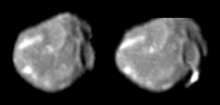Amalthea (moon)
Amalthea is the third closest moon to Jupiter. It was found on September 9, 1892, by Edward Emerson Barnard and named after Amalthea, a nymph in Greek mythology.[8] It is also known as Jupiter V.
 Galileo images of Amalthea | |||||||||
| Discovery | |||||||||
|---|---|---|---|---|---|---|---|---|---|
| Discovered by | E. E. Barnard | ||||||||
| Discovery date | September 9, 1892 | ||||||||
| Orbital characteristics | |||||||||
| Periapsis | 181,150 km[1] | ||||||||
| Apoapsis | 182,840 km[1] | ||||||||
Mean orbit radius | 181365.84 ± 0.02 km (2.54 RJ)[2] | ||||||||
| Eccentricity | 0.00319 ± 0.00004[2] | ||||||||
| 0.49817943 ± 0.00000007 d (11 h 57 min 23 s)[2] | |||||||||
Average orbital speed | 26.57 km/s[1] | ||||||||
| Inclination | 0.374 ± 0.002° (to Jupiter's equator)[2] | ||||||||
| Satellite of | Jupiter | ||||||||
| Physical characteristics | |||||||||
| Dimensions | 250×146×128 km³[3] | ||||||||
Mean radius | 83.5 ± 2.0 km[3] | ||||||||
| Volume | (2.43 ± 0.22)×106 km³[4] | ||||||||
| Mass | 2.08 ± 0.15×1018 kg[4] | ||||||||
Mean density | 0.857 ± 0.099 g/cm³[4] | ||||||||
| ~0.020 m/s² (~0.002 g)[1] | |||||||||
| ~0.058 km/s[1] | |||||||||
| synchronous[3] | |||||||||
| zero[3] | |||||||||
| Albedo | 0.090 ± 0.005[5] | ||||||||
| |||||||||
| 14.1 [7] | |||||||||
On Amalthea, Jupiter would be an amazing sight in its sky, looking 92 times bigger than the Full Moon. Amalthea is the biggest of the closer moons of Jupiter. Non-spherical and reddish in colour, it is thought to have of water ice with unknown amounts of other materials. Its surface has big craters and high mountains.[3]
Pictures of Amalthea were taken in 1979 and 1980 by the Voyager 1 and 2 spacecraft, and later, in more detail, by the Galileo orbiter in the 1990s.[3]
Discovery and naming
changeAmalthea was found on September 9, 1892 by Edward Emerson Barnard using the 36 inch (91 cm) telescope at Lick Observatory.[8] It was the first new moon of Jupiter since Galileo Galilei's discovery of the Galilean moons in 1610.
The moon is named after the nymph Amalthea from Greek mythology who nursed the infant Zeus (the Greek equivalent of Jupiter) with goat's milk.[8] Its Roman numeral designation is Jupiter V. The name "Amalthea" was not adopted by the IAU until 1975,[9] although it had been in use for many decades. The name was suggested by Camille Flammarion.[10] Before 1975, Amalthea was most commonly known simply as Jupiter V. The adjectival form of the name is Amalthean.
Orbit
changeAmalthea circles Jupiter at a distance of 181,000 km (2.54 Jupiter radii). The orbit of Amalthea has an eccentricity of 0.003 and an inclination of 0.37° relative to the equator of Jupiter.[2]
Physical characteristics
changeThe surface of Amalthea is very red [3] The reddish color may be due to sulfur coming from Io or some other non ice material.[3] Bright patches of green appear on the major slopes of Amalthea, but the nature of this color is currently unknown.[3] The surface of Amalthea is a bit brighter than surfaces of other closer moons of Jupiter.[5]
How Amalthea looks from Jupiter
changeFrom Jupiter's surface —or rather, from just above its cloudtops— Amalthea would appear very bright, shining with a magnitude of −4.7, similar to that of Venus from Earth.
How Jupiter looks from Amalthea
changeFrom the surface of Amalthea, Jupiter would look enormous: it would look 92 times bigger than the Full Moon.
Exploration
changeIn 1979-1980, the Voyager 1 and 2 spacecraft made the first images of Amalthea, which resolved its surface.[3] They also measured the moon's surface temperature. Later, the Galileo orbiter completed taking pictures of Amalthea's surface and a close flyby enabled it to constrain the moon's internal structure and composition.
References
change- ↑ 1.0 1.1 1.2 1.3 1.4 Calculated on the basis of other parameters
- ↑ 2.0 2.1 2.2 2.3 2.4 Cooper, N.; Murray, C.; Porco, C.; Spitale, J. (2006). "Cassini ISS astrometric observations of the inner jovian satellites, Amalthea and Thebe". ICARUS. 181 (1): 223–234. Bibcode:2006Icar..181..223C. doi:10.1016/j.icarus.2005.11.007.
- ↑ 3.00 3.01 3.02 3.03 3.04 3.05 3.06 3.07 3.08 3.09 Thomas, P.C.; Burns, J.A.; Rossier, L.; Simonelli, D.; Veverka, J.; Chapman, C.R.; Klaasen, K.; Johnson, T.V.; Belton, M.J.S. (1998). "The Small Inner Satellites of Jupiter". ICARUS. 135 (1): 360–371. Bibcode:1998Icar..135..360T. doi:10.1006/icar.1998.5976. Archived from the original on 2011-02-12. Retrieved 2007-12-07.
- ↑ 4.0 4.1 4.2 Anderson, John D.; Johnson, Torrence V.; Schubert, Gerald; Asmar, Sami; Jacobson, Robert A.; Johnston, Douglas; Lau, Eunice L.; Lewis, George; Moore, William B.; Taylor, Anthony; Thomas, Peter C.; Weinwurm, Gudrun (2005). "Amalthea's Density Is Less Than That of Water". Science. 308 (5726): 1291–1293. Bibcode:2005Sci...308.1291A. doi:10.1126/science.1110422. PMID 15919987. S2CID 924257. Archived from the original on 2007-06-28. Retrieved 2007-12-07.
- ↑ 5.0 5.1 Simonelli, D.; Rossier, Laura; Thomas, Peter C.; Veverka, Joseph; Burns, Joseph A.; Belton, Michael J. S. (2000). "Leading/Trailing Albedo Asymmetries of Thebe, Amalthea, and Metis". ICARUS. 147 (2): 353–365. Bibcode:2000Icar..147..353S. doi:10.1006/icar.2000.6474. Archived from the original on 2007-06-28. Retrieved 2007-12-07.
- ↑ Simonelli, D.P. (1982). "Amalthea: Implications of the temperature observed by Voyager". ICARUS. 54 (3): 524–538. Bibcode:1983Icar...54..524S. doi:10.1016/0019-1035(83)90244-0.
- ↑ "Classic Satellites of the Solar System". Observatorio ARVAL. Archived from the original on 2011-08-25. Retrieved 2007-09-28.
- ↑ 8.0 8.1 8.2 Barnard, E. E. (1892). "Discovery and Observation of a Fifth Satellite to Jupiter". Astronomical Journal. 12: 81–85. doi:10.1086/101715.
- ↑ "IAUC 2846: Satellites of Jupiter". Archived from the original on 2020-06-02. Retrieved 2020-09-14.
- ↑ USGS Astrogeology Research Program, Gazetteer of Planetary Nomenclature. Archived 2018-08-09 at the Wayback Machine
Other websites
change- Amalthea Profile Archived 2014-10-09 at the Wayback Machine by NASA's Solar System Exploration
- Another find for Galileo – Galileo Millennium Mission status report (2003-04-09)
- Jupiter's Amalthea Surprisingly Jumbled – JPL press release (2002-12-09)
- Jupiter From Amalthea, a painting by Frank Hettick, 2002.